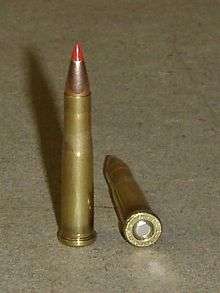Armalite AR-5
| Armalite AR-5 | |
|---|---|
| Type | Rifle |
| Place of origin | United States |
| Service history | |
| In service | 1956 |
| Used by | United States Air Force |
| Production history | |
| Manufacturer | ArmaLite |
| Specifications | |
| Weight | 2.5 lb |
| Length | 28" |
| Barrel length | 14"[1] |
|
| |
| Caliber | .22 Hornet |
| Action | Bolt-action |
| Feed system | 5-round detachable box magazine |
The Armalite AR-5 is a lightweight bolt-action rifle, chambered for the .22 Hornet cartridge, and adopted as the MA-1 aircrew survival rifle by the United States Air Force. It was developed by ArmaLite, a division of Fairchild Engine and Airplane Corporation in 1954.
History
The U.S. Air Force needed a compact, lightweight, accurate rifle for the new XB-70 manned bomber aircrew's survival kits.[2] Since the M4 and M6 aircrew survival weapons were no longer in manufacture, the Air Force put out a request for a new survival weapon. Shortly after Fairchild established the ArmaLite division in 1954, ArmaLite designed and submitted the AR-5 in response. The Air Force officially adopted the AR-5 as the MA-1 in 1956.[3] However, the Air Force never received funding to buy more than the original 12 test models due to the cancellation of the XB-70 fleet which left the number of M4 and M6 aircrew survival weapons already in inventory sufficient for existing Air Force needs.[2][4][5] Adoption of the MA-1 established ArmaLite as a recognized firearms company, leading to several other rifle designs of varying success (e.g., the AR-7, AR-10 and AR-15).[4]
Design

The earlier M6 Aircrew Survival Weapon is a superposed ("over-under") break action combination gun with a .22 Hornet single-shot rifle barrel over a .410 shotgun barrel. While there is versatility to such a combination, the AR-5's detachable box magazine fed bolt action has the advantage of rapid fire capability. The AR-5, like the M4 Survival Rifle and M6 US Air Force survival rifles, used the .22 Hornet cartridge which has 2.3 times the muzzle velocity and 7 times the energy of the common .22 Long Rifle (when comparing 40 gr bullets), and yet still has a light recoil.
Designed to be stowed in cramped aircraft cockpits, the rifle was made from lightweight plastics and aluminum alloys. The AR-5 was unique for being able to be disassembled with all working parts stored within the stock. When stowed in this manner, the rifle was able to float.[6]
Armalite used the research and tooling for the AR-5/MA-1 to develop the Armalite AR-7, an eight-shot semi-automatic rifle chambered for the .22 Long Rifle cartridge. Released in 1959 as a civilian survival weapon and in continuous production since then, the AR-7 is related to the AR-5 in terms of its overall layout, and retains the same modular takedown, storage in stock, and the ability to float.[3]
See also
- M4 Survival Rifle
- M6 Aircrew Survival Weapon
- Marble Game Getter
- List of individual weapons of the U.S. Armed Forces
- List of firearms
References
- ↑ Gordon L Rottman (20 October 2013). The Book of Gun Trivia: Essential Firepower Facts. Osprey Publishing. p. 168. ISBN 978-1-78200-620-6.
- 1 2 Bierman, Harris (1971). "Armalite AR5A". GUNS & AMMO ANNUAL. Petersen's Publishing. p. 298.
- 1 2 "ArmaLite history" (PDF). Archived from the original on 2008-10-01.
- 1 2 Long, Duncan (1990). AR-7 Super Systems. Boulder, Colorado: Paladin Press. pp. 4–5.
- ↑ Frank Miniter (11 August 2014). The Future of the Gun. New York: Regnery Publishing, Incorporated, An Eagle Publishing Company. pp. 30–31. ISBN 978-1-62157-244-2.
- ↑ Stevens, R. Blake & Edward C. Ezell (1987). The Black Rifle: M16 Retrospective. Cobourg, Canada: Collector Grade Publications. p. 22.
External links
- Design patent #179499 (January 01, 1957) George C. Sullivan (Inventor), United States Patent & Trademark Office, AR-5's gunstock design patent
- links to images of and/or articles about the AR-5 here and here